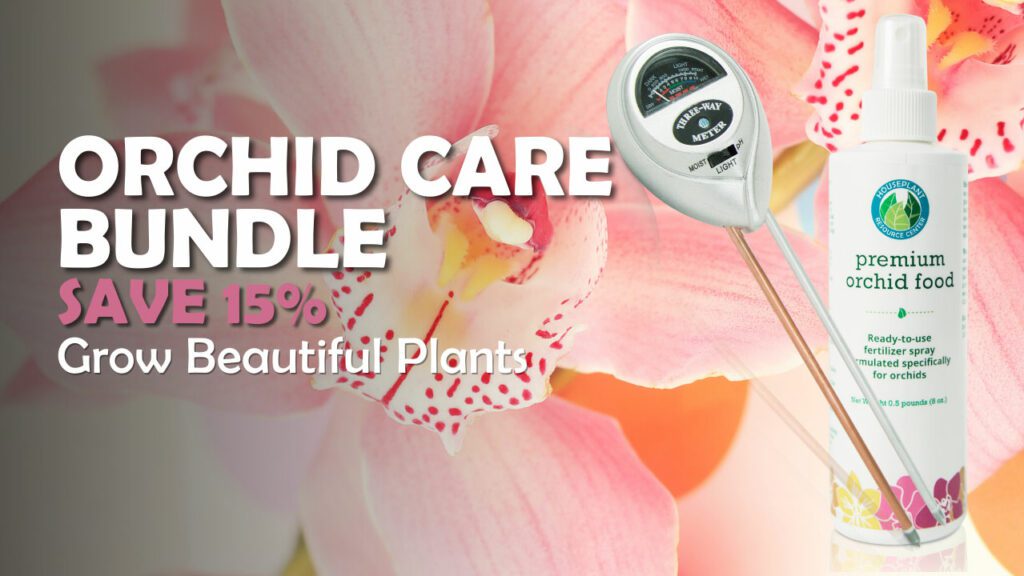Although some gardeners assume orchids are fussy plants that are difficult to care for, caring for an orchid can be quite simple. Provided your orchid receives the right amount of water, has access to sunlight, is potted in a mineral-rich potting mix, and is nourished with a gentle orchid fertilizer, your plant is sure to thrive year-round.
Below, we’ll cover exactly how to take care of your orchid so you can easily nurture your plants—whether you’re welcoming your very first orchid into your home or you have a collection of orchids already—and watch them burst into bloom and brighten up your home.
Orchid Care: Potting Needs
Like all epiphytic plants, orchids thrive in pots that allow for good drainage and plenty of aeration. Plastic pots, glass pots with plenty of pre-drilled holes, and clay pots are amongst the most popular choices for promoting healthy orchid growth.
Keep in mind that an orchid’s pot shouldn’t be too big. The bigger the pot, the more potting mix you’ll need to fill it, and since orchids’ roots need fresh air to survive, you may accidentally suffocate your plant under the weight of too much potting media.
Professional Tip: If your orchid comes in a decorative pot without drainage holes, which is common if you purchase your plant from a big-box store, you’ll want to buy a new pot for it and repot it within a few days of welcoming it into your home.
Orchid Care: Potting Mix
Because tropical orchids are epiphytes, they don’t grow in regular ground soil. Instead, tropical and subtropical orchids grow high up off the ground in the canopies of tropical rainforests. They cling to the branches of trees and absorb vital nutrients from the rainforest’s mineral-rich environment.
Most orchid species require special potting mix in order to thrive indoors. To keep your tropical orchids happy and healthy, use a potting mix designed for tropical orchids.
Terrestrial orchids, on the other hand, do grow in regular soil. These orchids are typically native to the Americas and thrive in potting mix designed specifically for terrestrial orchids.
Professional Tip: If you’d prefer to make your own tropical orchid potting mix, combine three parts fir bark, one part perlite, and one part sphagnum moss. These organic materials are perfect for supplying your orchid with nutrients and allowing water to drain from the pot quickly.
Orchid Care: Water Requirements
One of the key steps in keeping your orchid thriving for years to come is to dial in a proper watering routine. Because orchids have highly unique root systems, they are susceptible to root rot and shouldn’t be overwatered. The key to watering your orchid is to make sure the potting mix is allowed to fully dry between waterings.
An easy way to know if your orchid needs water is to insert the tip of your finger into the growing mix to check if the mix is dry. If the mix feels damp (or if you’re not sure), then don’t water your orchid.
Professional Tip: A good rule of thumb is to water your orchid no more than once a week, though different orchid types will require adjustments in watering. For most orchid types, you should reduce watering during the winter months. To make reading the moisture levels in your orchid’s potting mix easy, consider purchasing a moisture meter.
Orchid Care: Temperature and Humidity
When choosing a spot for your orchid, keep in mind that temperature requirements may vary by orchid type. Tropical orchids typically thrive in an environment between 60-75°F (16-24°C), while terrestrial orchids can tolerate much lower temperatures.
Humidity preferences will also vary by plant type, though it’s generally safe to assume tropical orchids will thrive in humid conditions. Most homes are far too dry for tropical orchid species, so placing your plant on top of a humidity tray goes a long way to keep your plant healthy. As water evaporates from the humidity tray, your orchid will bask in the moist air.
Professional Tip: To trigger blooms and help the plant maintain a healthy growth cycle, some orchid species prefer a drop in temperature by at least 10°F at night. This is best achieved by moving your orchid to a cooler location overnight, typically a basement room.
Orchid Care: Optimal Light Conditions
More often than not, orchids require bright, indirect light to maintain hearty roots and encourage plant growth. For orchids that enjoy bright light, try placing them in a south- or west-facing window. Keep in mind that direct sunlight can easily burn your orchid. Some growers choose to put a sheer curtain between the orchid and its light source to diffuse direct sun rays.
For orchids that enjoy low light conditions, try positioning them in an east- or north-facing window.
Professional Tip: If you’re considering moving your orchid outdoors for the summer months, keep in mind that in the wild, orchids live under thick rainforest canopies. They enjoy dappled light conditions, so a shaded area is best.
Orchid Care: Premium Orchid Food
Whether you’re new to orchid care or a seasoned professional, using a reliable orchid fertilizer to nourish your plant is essential. The right orchid food will support all of your efforts to provide the best conditions for your orchid.
Premium Orchid Food lets you grow beautiful, exotic orchids with ease. This product checks all the boxes. It’s gentle, easy to apply, and won’t burn your orchid’s roots.
Here are a few of the features that make Premium Orchid Food the go-to fertilizer for supporting your orchid plants:
- Easy application: The pre-mixed spray acts as a root stimulator for plants to improve their ability to use nutrients. This is especially important for young plants.
- Special formula: Sea kelp extract and humic acids address the unique needs of your orchid. With regular use, you’ll see healthy and vibrant orchids that grow larger year after year.
- Safe to use at every watering: The standard orchid fertilizer ratio is diluted, so it’s gentle enough to use at every watering without burning your orchid’s roots.
- It works with many orchid varieties: Premium Orchid Food is compatible with many indoor varieties, including phalaenopsis, epidendrum, Miltonia, cattleya, vanda, cymbidium, and oncidium.
Professional Tip: For best results, simply use Premium Orchid Food every time you water. Then sit back and watch your orchid’s blooms explode.
Join Our Orchid Care Facebook Community
In our Facebook group of orchid lovers, we’re dedicated to creating a rich and engaging environment where plant lovers can come together and share tips, tricks, and experiences.
If you’re an orchid lover, come join our Facebook community! We can’t wait to celebrate your successes and help you troubleshoot your care routine.
For continued success, you can explore our other articles or visit our online shop for plant care products that are sure to keep your plants boasting rich green leaves and big, bountiful blooms year-round.




It’s interesting to know that the humidity is also a factor to consider when taking care of orchid plants. I recently had a wall set up in my garden where orchid could cling to so I’d like to make sure that I wouldn’t mess up taking care of them. It’s going to be my first time buying exotic plants so I don’t want to make any mistakes.